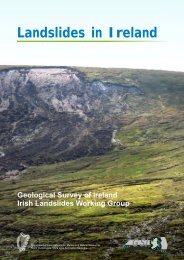PDF Download (2.6Mb) - Geological Survey of Ireland
PDF Download (2.6Mb) - Geological Survey of Ireland
PDF Download (2.6Mb) - Geological Survey of Ireland
You also want an ePaper? Increase the reach of your titles
YUMPU automatically turns print PDFs into web optimized ePapers that Google loves.
Geology Matters: Winter 2009<br />
The RV Keary<br />
The vessel is named after the celebrated geologist, Ray Keary, RIP. The RV Keary is a purpose<br />
built, aluminium catamaran designed for the survey <strong>of</strong> shallow waters, made possible by her<br />
shallow 1.7 metre draft. The 15 metre fully-equipped hydrographic/geophysical launch will<br />
also deliver survey data that will meet the required international surveying specifications.<br />
The minimum crew is 3 (Skipper, <strong>Survey</strong>or and Data Processor) but survey operations are<br />
usually undertaken by a crew <strong>of</strong> 4, operating during daylight hours, weather dependant (Sea<br />
state 4 or less).<br />
<strong>Survey</strong> operations throughout 2009 have been (and continue to be) concentrated on the<br />
remaining unsurveyed areas <strong>of</strong> Dublin Bay and completion <strong>of</strong> these will allow the UKHO to<br />
update the Dublin Chart in 2010. The first chart <strong>of</strong> Dublin Bay was undertaken in 1800 by<br />
Captain William Bligh, famous for the “Mutiny on the Bounty” incident and later went on to be<br />
the Governor <strong>of</strong> Australia. He completed the chart in 1803 and it was considered the most<br />
accurate map <strong>of</strong> the bay well into the 20th century!<br />
The RV Keary was commissioned to complement the survey capabilities <strong>of</strong> the Marine<br />
Institute vessels, the Celtic Explorer and the Celtic Voyager. The Explorer carries out deep<br />
sea mapping and research, the Voyager carries out mapping in median waters and there<br />
was a need for a state vessel to map our shallowest waters.<br />
Keary Specification<br />
Registered Dublin.<br />
Call Sign EIGO9.<br />
MSO P5 Licence for 12 Passengers.<br />
Vessel contract awarded to IMAR Tionscail with the assistance<br />
<strong>of</strong> Maritime Services Ltd<br />
Design by Nic De Waal <strong>of</strong> Teknicraft New Zealand<br />
Manafactured by Veecraft Marine <strong>of</strong> Capetown, South Africa<br />
Leading Particulars<br />
Length (OA)<br />
Length (Hull)<br />
Beam (moulded)<br />
Draft<br />
Engines<br />
Rating<br />
Speed (90% power)<br />
Fuel<br />
Hull Type<br />
Construction<br />
Equipment<br />
15.5 m<br />
14.6 m<br />
5.6 m<br />
1.7 m<br />
Cummins QSC 8.3-500 INT<br />
368 kW/2600 rpm<br />
22 kn<br />
2000 lt<br />
Asymmetrical catamaran<br />
Marine Grade Aluminium<br />
Simrad 3002D Multibeam, USBL, GPS<br />
systems, Applanix POS-MV, CHIRP,<br />
Single Beam, Quincy Navigation s<strong>of</strong>tware,<br />
AIS, SOLAS, Radar, AutoPilot<br />
Ray Keary RIP<br />
Ray Keary was a respected and important employee <strong>of</strong> the GSI<br />
for over two decades, where he founded the Marine Geology<br />
programme, having worked with NUIG for fifteen years prior to<br />
that. His influence in his chosen field <strong>of</strong> Marine Science was<br />
huge and his outstanding legacy is <strong>Ireland</strong>’s seabed mapping<br />
programme that he tirelessly lobbied for.<br />
page 5

















